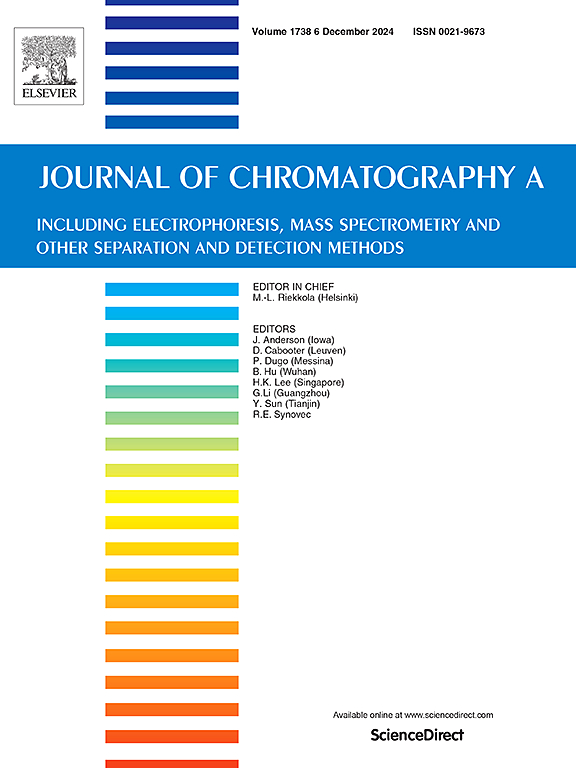超高压回旋色谱法:应用于细胞和基因治疗相关的大量 DNA 和 RNA 样品的表征。
IF 3.8
2区 化学
Q1 BIOCHEMICAL RESEARCH METHODS
引用次数: 0
摘要
回旋色谱法(SC)最初是由 Boyes 和 Kasai 在 20 世纪 80 年代末共同发现的,最近再次成为快速分析 DNA 样品的突破性技术。随着最先进的超高压液相色谱(UHPLC)系统和色谱柱的发展,SC 现可为分析大量 DNA 样品提供更高的分辨率和灵敏度。通过重新审视 SC 保留机制(非平衡分离模式)的基本原理,并考虑 DNA 生物聚合物的理化特性(轮廓长度、剪切流下的延伸、弛豫时间),我们为分析化学家提供了在不断扩大的细胞和基因治疗领域选择最相关应用的一般策略和框架。然后,我们展示了概念验证数据,这些数据证明了能快速分离(不到 2 分钟)含有线性双链 (ds) DNA 大分子的质粒消化样本(从 2 kbp 到 25 kbp),并能准确测定线性 dsDNA 的大小(±6%)。此外,我们还展示了快速基线分离和量化可延伸线性dsDNA以及刚性较强的质粒dsDNA(超卷曲/环状/挑刺环状)的方法。我们还量化了用于生产新型 mRNA 疗法的体外转录 (IVT) 培养基中的 dsRNA 杂质,并评估了 dsRNA 的结构异质性(构象异构体)。这些发现旨在通过提供先进的 SC 色谱柱和方法,帮助应用化学家在不久的将来应对细胞和基因治疗领域新出现的生物分析挑战。本文章由计算机程序翻译,如有差异,请以英文原文为准。
Ultra-high pressure slalom chromatography: Application to the characterization of large DNA and RNA samples relevant in cell and gene therapy
Slalom chromatography (SC), initially co-discovered by Boyes and Kasai in the late 1980s, has recently re-emerged as a breakthrough technique to rapidly analyze DNA samples. With the development of cutting-edge ultra-high pressure liquid chromatography (UHPLC) systems and columns, SC now offers enhanced resolution and sensitivity for analyzing large DNA samples. By revisiting the fundamentals of the SC retention mechanism (non-equilibrium separation mode) and considering the physicochemical properties of DNA biopolymers (contour length, extension under shear flow, relaxation time), we provide analytical chemists with a general strategy and framework for selecting the most relevant applications in the expanding field of cell and gene therapy. We then present proof-of-concept data demonstrating the rapid separation (under 2 min) of plasmid digest samples containing linear double-stranded (ds) DNA macromolecules starting from 2 kbp to 25 kbp, as well as the accurate size determination (6%) of linear dsDNAs. Additionally, we show rapid baseline separation and quantification of extensible linear dsDNAs, along with the more rigid plasmid dsDNA (supercoiled/circular/nicked circular). We also quantify dsRNA impurities present in vitro transcription (IVT) media used for producing new mRNA therapeutics and assess dsRNA structural heterogeneity (conformational isomers). These findings aim to support in a near future application chemists in addressing emerging bioanalytical challenges in cell and gene therapy by offering advanced SC columns and methods.
求助全文
通过发布文献求助,成功后即可免费获取论文全文。
去求助
来源期刊

Journal of Chromatography A
化学-分析化学
CiteScore
7.90
自引率
14.60%
发文量
742
审稿时长
45 days
期刊介绍:
The Journal of Chromatography A provides a forum for the publication of original research and critical reviews on all aspects of fundamental and applied separation science. The scope of the journal includes chromatography and related techniques, electromigration techniques (e.g. electrophoresis, electrochromatography), hyphenated and other multi-dimensional techniques, sample preparation, and detection methods such as mass spectrometry. Contributions consist mainly of research papers dealing with the theory of separation methods, instrumental developments and analytical and preparative applications of general interest.
 求助内容:
求助内容: 应助结果提醒方式:
应助结果提醒方式:


